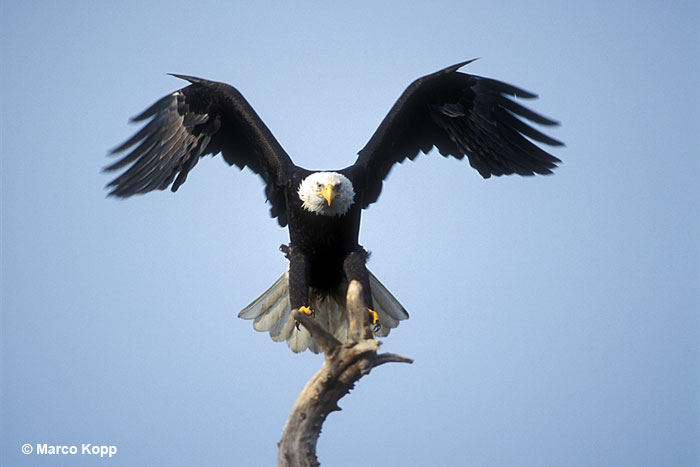
The birds of Alaska include 541 species of seabirds, raptors, ducks, and much more!
Only in Alaska, Bald Eagles are common, everyday birds, several owls call from the woods, and sandpipers sing on the tundra.
Alaska is definitely one of the wilder and more exciting places to watch birds. Which bird species have you seen in Alaska?
We bet you’ve seen a lot of amazing species but how many could you identify?
This list of the 20 common birds in Alaska will help!
On this page
- Most Common Birds of Alaska (top 20)
- Common Raven
- Bald Eagle
- Mallard
- Glaucous-winged Gull
- Black-billed Magpie
- Black-capped Chickadee
- Short-billed Gull
- Dark-eyed Junco
- American Crow
- American Robin
- Bufflehead
- Red-breasted Nuthatch
- Harlequin Duck
- Song Sparrow
- Common Merganser
- Common Goldeneye
- Pelagic Cormorant
- Common Redpoll
- Chestnut-backed Chickadee
- American Wigeon
- FAQ
Most Common Birds of Alaska (top 20)
According to eBird data from 2021 to 2023, our list shows the 20 most common birds of Alaska.
To help recognize them, we included information about their behavior and field marks (the species on the bottom of the list are common birds too!).
Common Raven
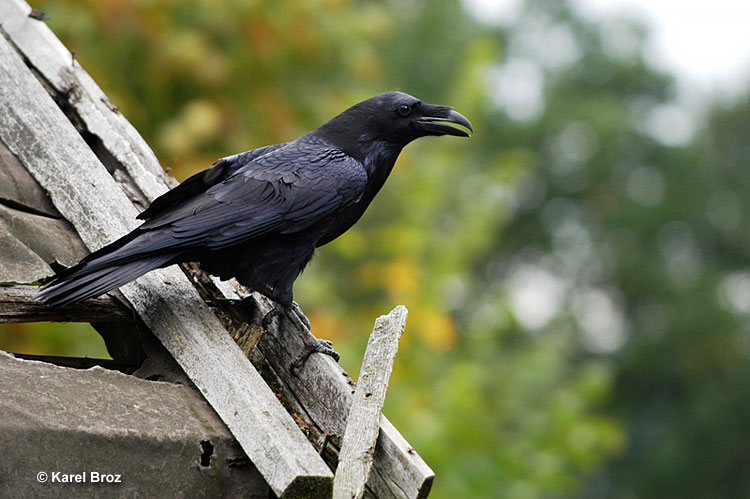
Scientific name: Corvus corax
Length: 24 inches
Weight: 2.6 pounds
Wingspan: 53 inches
Song: “Grauk Grauk Grauk Grauk!”
The Common Raven is a big, black crow-like bird with long, broad wings and a broad, wedge-shaped tail.
Both sexes look alike and have feathers extending onto the top part of their strong, stout beaks.
This bird is often seen in soaring flight or in direct flight where it gives a few strong flaps between glides.
Common Ravens are omnivores that feed on carrion, small animals, nesting birds, and various other food items. They forage by flying above roads and other places and are always on the lookout for feeding opportunities.
This big Corvid makes a big, bulky nest out of sticks and lines the shallow cup with mud, wool, and other items. It builds its nest on a cliff, tree, bridge, or other structure.
The Common Raven lives in wilderness areas from the Arctic to parts of the northeastern USA and the western USA. In some places, it lives in urban areas. Common Ravens are the most common birds in Alaska.
Key Identifications:
- Huge, black, crow-like bird with a strong, stout beak and a wedge-shaped tail.
- An omnivore that feeds on small animals, carrion, and other food items.
- Makes a big bulky stick nest in trees, on cliffs, and on human-made structures.
- Common Ravens are vocal birds. One of their most common calls is a load and croaking, “Grauk Grauk Grauk Grauk!”.
The Common Raven is a large, black, crow-like bird of mountains, forest, tundra, and other wild areas. Some also live near people and, in flight, they can sometimes be mistaken for raptors. However, no hawk species is entirely black with a wedge-shaped tail. The Common Raven can mimic human speech and is one of the most intelligent bird species.
Bald Eagle
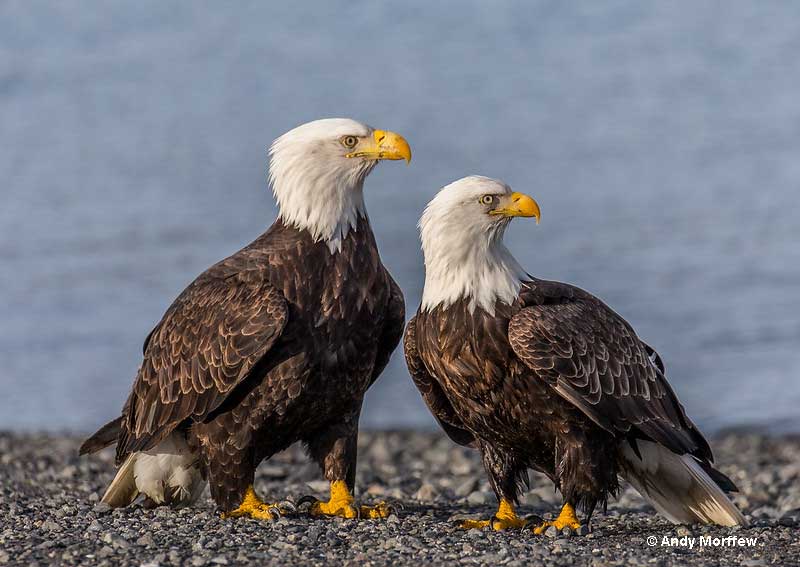
Judging by the size, female is on the left and male is on the right. Photograph © Andy Morffew
Scientific name: Haliaeetus leucocephalus
Length: 31 inches
Weight: 9.5 pounds
Wingspan: 80 inches
Song: “pip pipipipip!”
The Bald Eagle is a huge, dark brown raptor with a white head, white tail, and a big yellow beak. Males and females look the same except that females are bigger.
Young birds are dark brown with mottled white and have a mostly dark beak.
In flight, Bald Eagles soar on broad, long wings held flat like a board. They also have deep and slow wing beats.
The Bald Eagle snatches fish from the surface of lakes, rivers, and other shallow wetlands. It also feeds on carrion and occasionally catches small mammals and birds as big as a Canada Goose.
This big raptor builds a big, bulky stick nest high in a tree in or near wetlands. They often use the same nest year after year.
Bald Eagles occur in a variety of wetland habitats in Alaska, Canada, most of the USA (including Alaska), and in some parts of northern Mexico.
Key Identifications:
- Although adult Bald Eagles are unmistakable, young birds can be confused with the Golden Eagle. They are best recognized by their mottled plumage, huge beak, and flat, soaring wings.
- Preys on fish, small mammals, ducks and geese, and also eats carrion.
- Builds a big, bulky nest out of sticks in wetland habitats.
- Bald Eagles make brief, whistled piping calls, “pip pipipipip!”.
The Bald Eagle is a huge raptor with a white head and tail, young birds are dark brown with white mottling. This bird of prey catches fish and aquatic animals and feeds on carrion in many wetland habitats.
Mallard
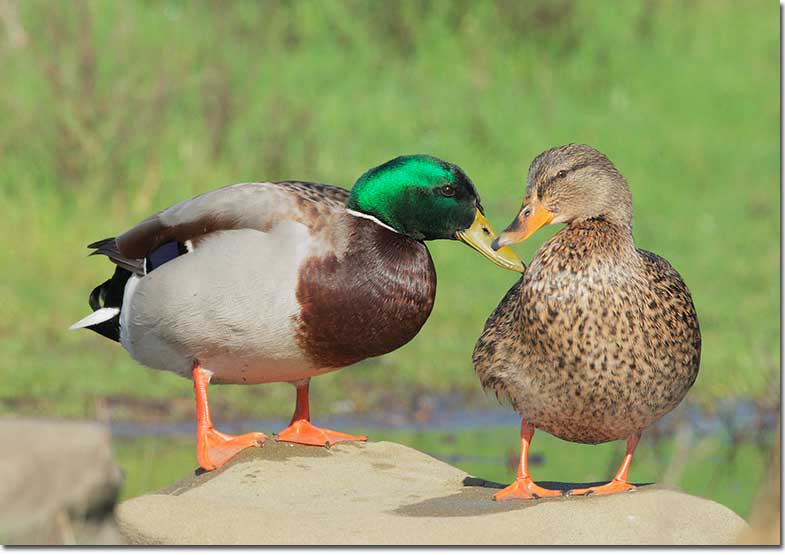
Mallard pair (Male and female)
Scientific name: Anas platyrhynchos
Length: 23 inches
Weight: 2.4 pounds
Wingspan: 35 inches
Song: “quack, quack”
The Mallard is a fairly large, familiar duck. The male has a metallic green head, yellow bill, narrow white ring around the neck, and chestnut breast. The rest of the bird is pale gray with pale brown, and black on its back and around his tail.
Female Mallards are mottled brown and buff with a dark crown and line through the eyes, and have a dark gray and orange beak.
Related: “Odd” Ducks
In flight, both sexes show a green-blue wing patch bordered with white.
Mallards eat a variety of items including insect larvae, snails, other small aquatic creatures, acorns, seeds, and grain. They forage by filtering and picking up food items in and near shallow water, and in farm fields.
This Alaska duck species makes a shallow nest with sticks and lined with down feathers. It builds its nest on the ground, hidden in grass or under a bush.
The Mallard lives in ponds, marshes, and many wetland habitats in Canada, USA, and Eurasia.
Key Identifications:
- Feeds on insect larvae, grain, seeds, and other items picked up with its bill in and near shallow water.
- Makes a shallow stick nest hidden in grass or under a bush.
- The female Mallard makes the classic “quack, quack” duck sound. Males make similar but softer sounds and a whistling call.
The Mallard is a fairly large and familiar duck with a dark green head (the male), or is buff and brown with a dark gray and orange beak (the female). Thus duck species often lives near people and occurs on lakes, ponds, and other wetlands. No matter how different they look, most small domestic duck species are descended from wild Mallards.
Glaucous-winged Gull
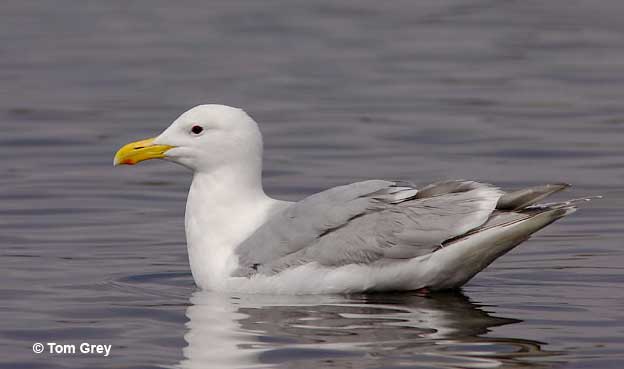
Scientific name: Larus glaucescens
Length: 26 inches
Weight: 2.2 pounds
Wingspan: 58 inches
Song: “kea keea keea keea keea”
The Glaucous-winged Gull is a big, pale gray and white gull with gray and white wing tips, and pink legs.
Both sexes look similar, and, in winter have pale brown on their neck and head. Young birds in their first year are uniform pale gray-brown (including their wingtips) and have a blackish beak.
At two years of age, they have some pale gray on their back. Three year old birds resemble adults but have a dark tip on their pale beak, and more markings on their head and neck.
Glaucous-winged Gulls forage in coastal waters and beaches for fish, crustaceans, carrion, smaller birds, and any other small animals they can catch. We often see these big gulls in flocks, especially in areas with spawning salmon.
This species makes a basic nest on the ground, out of grass, sticks, and other items. They usually nest on rocky islands and occur in coastal waters from Alaska to Baja California.
Key Identifications:
- Large, pale, gray and white gull with pink legs, and gray and white wing tips.
- Small flocks roam beaches and coastal waters for fish, sea creatures, carrion, and small animals.
- They make a basic nest on the ground, usually on a rocky island.
- Glaucous-winged Gulls sound a lot like other large gulls. They make repeated cawing or honking sounds, “kea keea keea keea keea”.
The Glaucous-winged Gull is a large, white gull with a pale gray back, and gray and white wing tips. This gull species roams coastal areas in search of fish, small animals, and carrion. Most Glaucous-winged Gulls in Washington state are actually “Olympic Gulls”, a hybrid between this species and the Western Gull.
Black-billed Magpie
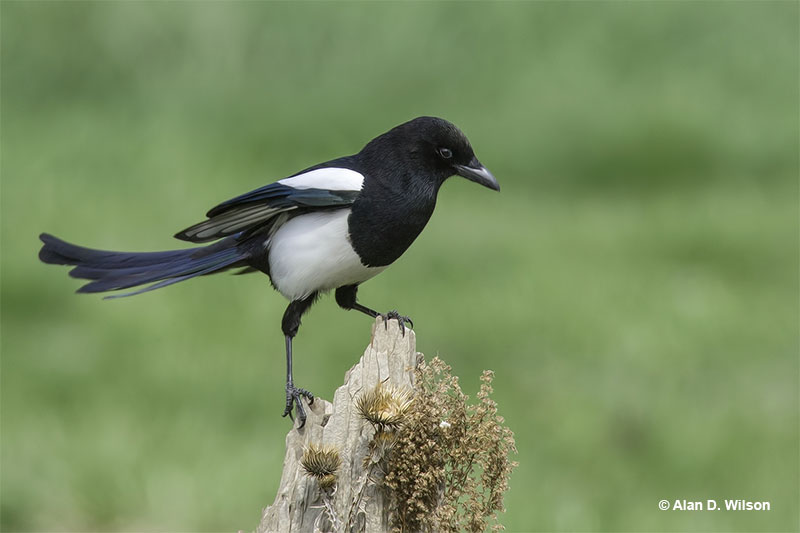
Scientific name: Pica hudsonia
Length: 19 inches
Weight: 6 ounces
Wingspan: 25 inches
Song: “reh reh reh reh reh!”
The Black-billed Magpie is a big, bold, black and white bird with a long tail. This relative of crows and jays has a stout, crow-like beak and glossy green and purple in its wings and tail.
Males and females look alike and also show bold white wing patches in flight. These birds fly with a few flaps followed by short brief glides and usually occur in groups.
They are omnivorous and eat a wide variety of food items. In winter, magpies often scavenge animals killed by predators as well as roadkill. They and also eat insects, small animals, seeds, and other items.
Black-billed Magpies make domed nests out of sticks and mud, and build them in trees and on poles and other structures.
This species lives in a variety of open, semi-open, and wooded habitats in Alaska, western and central Canada, and much of the western USA south to New Mexico.
Key Identifications:
- Medium to large black and white bird with a black beak, and a long, glossy green and purple tail.
- Feeds on carrion, small animals, seeds, and other food scraps.
- Makes a domed nest out of mud and sticks.
- This vocal bird makes a repeated raspy vocalization, “reh reh reh reh reh!”.
The Black-billed Magpie is a bold black and white bird with a long tail. They often occur in groups that forage on carrion, small animals, and other food scraps. This species often perches on cows, Moose, and other large herbivores to eat the ticks that attach to these large animals.
Black-capped Chickadee
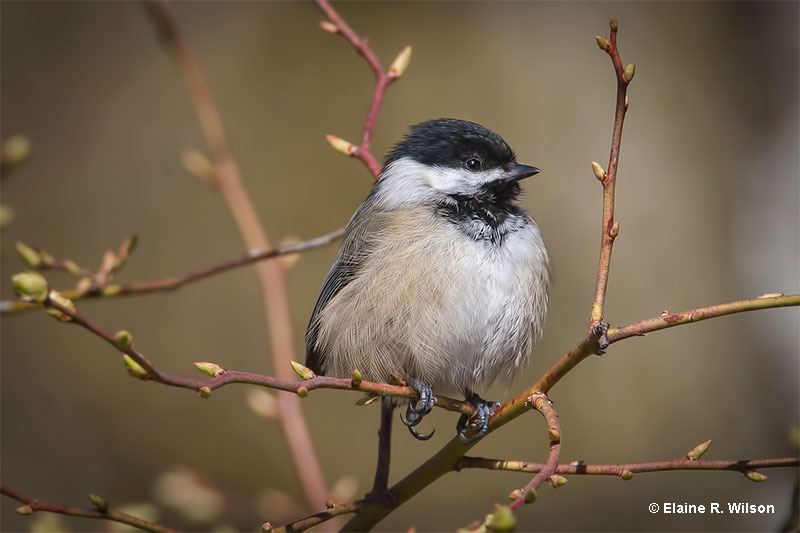
Scientific name: Poecile atricapilla
Length: 5.25 inches
Weight: .39 ounces
Wingspan: 8 inches
Song: “see bee, see bee”
Black-capped Chickadees are small grayish birds with a black cap, black throat, and a stubby black beak. Both sexes look alike and have a white face, white edging to the feathers in their wings, and some buff on their underparts.
These cute little birds feed on caterpillars, insects, spiders, seeds, and fruit. They are regular visitors to feeders but also forage on bark, twigs, and in foliage. When foraging, they often hang upside down from twigs and usually occur in small flocks.
This species makes a small, soft nest out of moss and deer hair. It builds its nest in tree cavities and can also use nest boxes.
Black-capped Chickadees live in a variety of wooded habitats and can also occur in gardens. They are year-round residents in parts of Alaska, Canada, and the northern USA south to Oregon, northern New Mexico, northern Ohio, and the Appalachian Mountains to North Carolina.
Key Identifications:
- Small, cute, grayish birds with a black cap, white face, and a black throat.
- Forages for insects, spiders, seeds, and fruit in wooded habitats. Also visits feeders.
- Nests in tree cavities and nest boxes.
- This little bird is quite vocal and often says its name, “chick-a-deedeedeedeedee”. They also make other chattering calls and sing a whistled song, “see bee, see bee”.
The Black-capped Chickadee is a small, acrobatic bird with a black cap, white face, and a black throat. It is also a state bird of Massachusetts. They usually forage in flocks with other chickadees and other small birds, and often visit feeders. This species hides dozens of seeds and other bits of food for the winter, and recalls where each of these food items are hidden.
Short-billed Gull
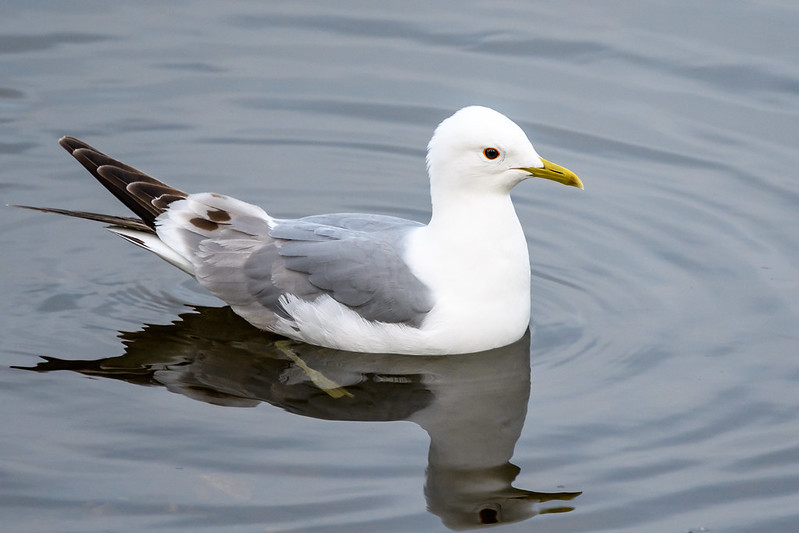
Image Copyright: Becky Matsubara (Flickr)
Scientific name: Larus brachyrhynchus
Length: 16 inches
Weight: 15 ounces
Wingspan: 43 inches
Song: “ree ree reah reah reah ruh ruh ruh ruh ruh ruh ruh”
The Short-billed Gull is a smallish gull with a white head and underparts, dark eyes, and slight yellow beak.
Both sexes look the same and have a gray back, and black and white tips on their gray wings. In addition, adults also have yellowish legs, and, in winter, have brownish markings on their neck and head, and a faint ring on their bill.
Younger Short-billed Gulls have grayish legs, a more bicolored beak, and have more uniform gray-brown coloration on their body, tail, and wings.
This gull species forages by picking up fish, small creatures, and other bits of food from seashores, and other coastal habitats.
Related: Do penguins live in Alaska?
Short-billed Gulls can nest on the ground on islands and coastal habitats, or in trees. They build a bulky, flat nest out of sticks.
This species breeds in wetlands and coastal habitats in Alaska and parts of western Canada. It winters in coastal areas from Alaska to California.
Key Identifications:
- Smallish gull with a slight yellowish beak, yellowish legs, and black and white wing tips.
- Forages for fish, small creatures, and other food scraps in wetlands and coastal habitats.
- Nests on the ground or in trees in or near wetlands.
- They make loud, sharp “laughing” vocalizations, “ree ree reah reah reah ruh ruh ruh ruh ruh ruh ruh”
The Short-billed Gull is a smallish gull with yellowish or grayish legs, a “weak” beak, black and white wing tips, or rather uniform plumage. In its range, this species is a common bird of wetlands and coastal habitats. Short-billed Gulls used to be known as “Mew Gulls” and were considered the same species as the Eurasian Common Gull.
Dark-eyed Junco
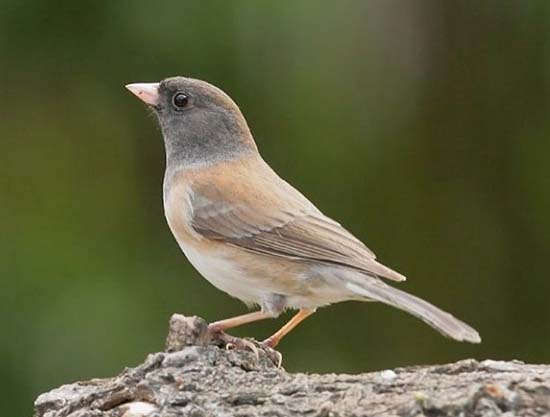
Scientific name: Junco hyemalis
Length: 6.25 inches
Weight: .67 ounces
Wingspan: 9.25 inches
Song: “sipsipsipsipsipsipsip”
Dark-eyed Juncos are sparrow-like birds with pale conical bills and dark eyes. This small bird has variable plumage with most being slate gray or gray and brown with white on their bellies, and white under their tails.
Other plumages include birds with dark masks and faint white wing bars, juncos with pale gray hoods and pinkish sides, and birds with blackish hoods and chestnut sides.
In flight, all Dark-eyed Juncos show extensive white in their longish tails.
This species feeds on seeds, insects, and some fruit and grain. Juncos forage on the ground in wooded areas, parks, and other habitats. They also feed on fallen seed beneath feeders.
They build cup nests on the ground under fallen logs, in roots, and other hidden spots. After breeding, juncos form flocks that forage together in similar wooded and semi-open habitats.
Dark-eyed Juncos are common birds in Canada, the USA, and parts of Mexico.
Key Identifications:
- Sparrow-like gray and brown bird with dark eyes, a pale beak, and white in the tail.
- Forages for seeds and insects on the ground, can feed on seeds at and beneath feeders.
- Builds a cup-shaped nest on the ground in tree roots, under logs, and other hidden places.
- This species often makes a sharp, high-pitched chip note, “pik!”. On breeding grounds, males sing a short, plain trill, “sipsipsipsipsipsipsip”.
Dark-eyed Juncos are sparrow-like, gray and brown birds with much white in the tail. Common wintering birds in many areas, they forage for seeds on the ground in wooded and park-like habitats. In many places, this common species is also known the “Snowbird” on account of only occurring in the winter months and having white on the belly and tail.
American Crow

Scientific name: Corvus brachyrhynchos
Length: 17.5 inches
Weight: 1 pound
Wingspan: 39 inches
Song: “Caw! Caw!”
The American Crow is a big, all black bird with a strong, stout bill. In certain lighting, it can have metallic purple and blue iridescence.
Both sexes look the same and have some feathering on their beaks, long, broad wings, and a broad tail.
American Crows have direct flight with strong, steady wing beats. Crows are very social and intelligent birds that are usually seen in flocks. They forage together on the ground or in trees and eat just about anything they can find.
Some of their more regular foods include carrion, fruit, nuts, seeds, insects, and small animals. Like most jays and crow species, they also eat the eggs and nestlings of other bird species.
This species builds bulky stick nests high in trees and lives in most habitats except for high mountains and arid zones.
The American Crow occurs in southern Alaska and much of Canada and the USA.
Key Identifications:
- Big, all black bird with long, broad wing and a broad tail.
- Forages for carrion, fruit, seeds, insects, and small animals.
- Builds a bulky stick nest high in a tree.
- American Crows are very vocal birds. They can make several calls but their most common one is, “Caw! Caw! Caw!”.
The American Crow is a common, large black bird that frequently calls, “Caw! Caw! Caw!”. It usually occurs in flocks and lives in all sorts of places, even urban zones. These birds are very smart and have funerals or wakes! When a crow dies, other crows mark the occasion by gathering together and loudly calling.
American Robin
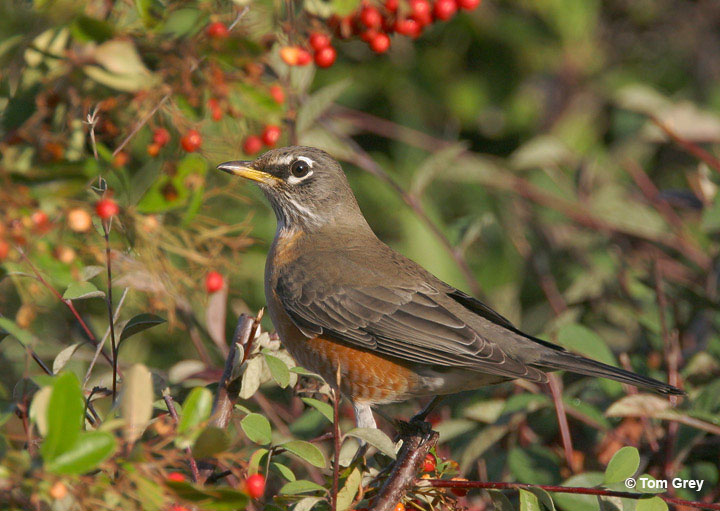
Scientific name: Turdus migratorius
Length: 10 inches
Weight: 2.7 ounces
Wingspan: 17 inches
Song: “cheery, cheery, cheery, cheery, cheer, cheer”
The American Robin is a familiar and common thrush that is dark gray above and brick red below. It also has an orange-yellow bill, a blackish head with white markings around the eyes and on the throat, and a white belly.
Both sexes of this thrush species are similar but males are darker above and more reddish on the underparts. Young American Robins have more white marks on their faces and spotting on orange underparts.
In flight, this common thrush in Alaska also shows white corners in its outer tail feathers.
American Robins forage on the ground for worms, insects, snails, and other small creatures. In winter, these common birds flock together and perch in trees and bushes to eat berries and fruit.
The American Robin makes a cup nest in trees and lives in parks, woodlands, towns, and many other habitats. They reside in Alaska, most of Canada, the USA and in Mexico.
Key Identifications:
- Fair-sized songbird that is dark gray above, and brick red and white below.
- Forages for worms and bugs on lawns and other open grassy areas, also flocks together to feed on fruiting trees in the winter.
- Makes a cup nest in trees.
- The American Robin is quite vocal and makes a loud, sharp, “yenk!” call and quieter “check,check,check” calls. It also has a lovely cheerful song of caroled phrases, “cheery, cheery, cheery, cheery, cheer, cheer”.
With an estimated population of 370 million, the American Robin is considered to be the most numerous landbird in North America.
Bufflehead
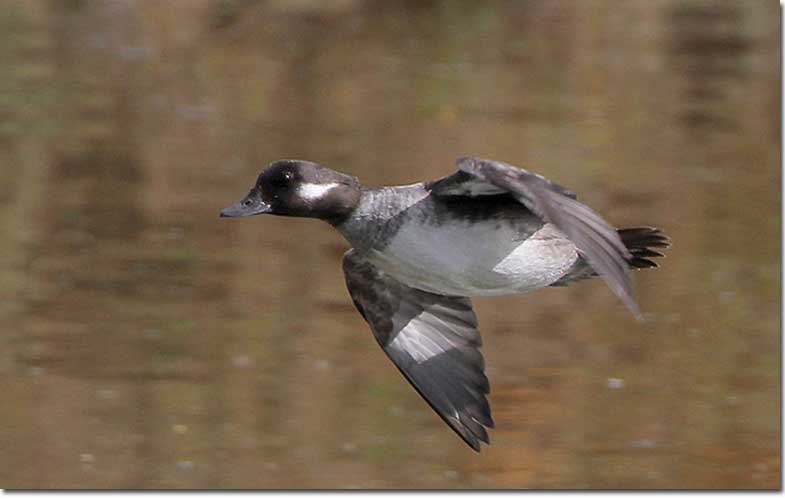
Scientific name: Bucephala albeola
Length: 13.5 inches
Weight: 13 ounces
Wingspan: 21 inches
Song: “reuh reuh reuh reuh”
The Bufflehead is a dainty diving duck with a small gray beak, and a rounded head. Breeding males have glossy purple and green highlights on their black and white head. They also have snow white underparts, and a black back.
During their swift, direct flight, male Buffleheads show a big white patch on each of their pointed wings. Non-breeding males, females, and juveniles are like males but are darker brown-gray, have a white belly, and a smaller white patch on their head.
Buffleheads dive in cold lakes, rivers, and coastal waters to forage for crustaceans and other small aquatic creatures. In migration, and winter, they usually occur in flocks.
This small duck nests in old woodpecker holes in boreal forest in Alaska, Canada, and parts of northern California and the Rocky Mountains. It winters in coastal areas, and on large bodies of water from Alaska and eastern Canada south to the USA and northern Mexico.
Key Identifications:
- Very small, black and white diving duck with a prominent white mark on its head.
- Dives in large, cold bodies of water to forage for small creatures on the bottom.
- Nests in old woodpecker holes.
- This duck is usually quiet but makes occasional brief rasping calls, “reuh reuh reuh reuh”.
The Bufflehead is a small, common diving duck with a big, rounded, black and white head. In winter, flocks dive for crustaceans on large lakes, bays, and reservoirs. Unlike many other duck species, the Bufflehead can mate for life and relies on holes made by flickers for nesting.
Red-breasted Nuthatch

© Elaine R. Wilson
Scientific name: Sitta canadensis
Length: 4.5 inches
Weight: .35 ounces
Wingspan: 8.5 inches
Song: “yeank, yeank, yeank”
The Red-breasted Nuthatch is a small, warbler-sized bird with a dark gray, straight or slightly upturned beak, gray upperparts, and reddish-orange underparts. It also has a black cap, a white face with a narrow black mask, and black and white in its short tail.
Males and females are similar except that females are paler and have a gray cap.
Red-breasted Nuthatches eat insects during the summer and conifer seeds in the winter. These small, animated birds forage by creeping down coniferous tree trunks and on branches. They use their bills to probe bark and pick out insects and seeds.
This species excavates a tree cavity and makes an open nest of bark and other vegetation.
The Red-breasted Nuthatch lives in coniferous and mixed forests in southern Alaska, Canada, and the western and northern USA. They also breed in the Appalachians and can be seen in most of the USA in winter.
Key Identifications:
- Small, short-tailed bird with a narrow white eyebrow, black mask, gray upperparts, and reddish-orange underparts.
- Creeps along tree trunks and branches to forage for insects and conifer seeds.
- Nests in tree cavities.
- The distinctive nasal call of the Red-breasted Nuthatch, “yeank, yeank, yeank”, is a good way to find this bird.
The Red-breasted Nuthatch is a small, short-tailed bird with black and white on its head, gray upperparts, and reddish-orange underparts. It usually occurs alone and lives in coniferous woods and trees. To protect its nest, this species puts sticky pine resin around the border of its nesting hole.
Harlequin Duck
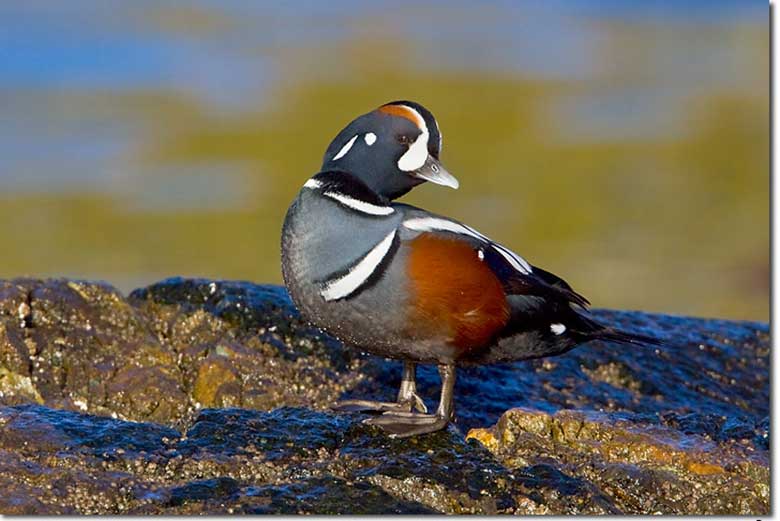
Scientific name: Histrionicus histrionicus
Length: 16.5 inches
Weight: 1.3 pounds
Wingspan: 26 inches
Song: “wuk weh wuk wuk wuk weauh weauh weh wuh”
The Harlequin Duck is a small duck with a short grayish beak, pointed tail, and a round white spot on each side of its head.
Males are dark gray, have a white crescent mark on the front of their face, and a few white lines on their neck and upperparts. They also have chestnut flanks and a bit of chestnut on their head.
Female Harlequin Ducks have some white on the front part of their face, and are dark brown with a white belly.
Harlequin Ducks forage by diving in swift and rough waters for crabs and other marine invertebrates.
This duck species makes a shallow nest in crevices, tree stumps, and other spots with some overhead cover.
Harlequin Ducks breed along rivers and streams in Alaska, western and eastern Canada, and in some parts of the northwestern USA. They also nest in Greenland, Iceland, and northeastern Asia. This species mostly winters in northern coastal waters.
Key Identifications:
- Small dark duck with a short beak, pointed tail, and odd white markings on its head.
- Dives in swift waters or rough surf for crabs and other invertebrates.
- Nests on the ground in tree stumps, crevices, and other spots with some overhanging structure.
- They make occasional odd vocalizations, “wuk weh wuk wuk wuk weauh weauh weh wuh”.
The Harlequin Duck is a small, dark duck with a pointed tail, short beak, and some white markings on its head and body. This species is an uncommon bird of fast, cold rivers, and rough surf near rocks and jetties. Harlequin Ducks are the only duck species in North America that specialize on fast rivers with rapids.
Song Sparrow
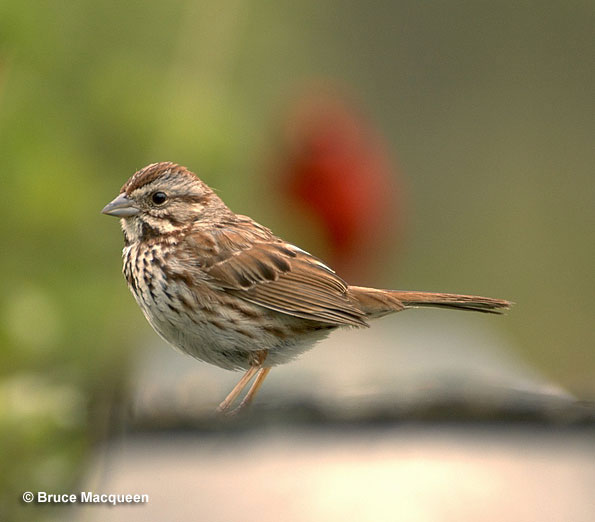
Scientific name: Melospiza melodia
Length: 6.25 inches
Weight: .7 ounces
Wingspan: 8.25 inches
Song: “seet serate sitsziziziziziziziz seet”
The Song Sparrow is a small, gray and brown, streaked songbird with a thick dark mark on each side of its white throat. Males and females look the same and have white underparts with a dark brown mark on their breast, and dark brown streaks on their breast and sides.
Most Song Sparrows also have two narrow wing bars and show a rounded tail when fluttering between bushes.
This species feeds on insects, seeds, and small fruits. Pairs forage by picking up food items on and near the ground. They are also frequent visitors to bird feeders.
Song Sparrows use grass, stems, hair, and other materials to make a cup nest placed on or near the ground. They nest in dense vegetation, shrubbery, or low trees, often near water.
This species uses a wide variety of brushy habitats in open and wooded situations in southern Alaska, most of Canada, and all of the USA.
Key Identifications:
- Small brown, streaked sparrow with a dark mark on its breast.
- Forages on and near the ground for seeds and insects in brushy habitats.
- Builds a cup nest on or near the ground in a shrub or low tree.
- Makes high-pitched “tink”, chirping calls, and has a cheerful song with a trill, “seet serate sitsziziziziziziziz seet”.
Song Sparrows are reddish-brown songbirds with dark brown streaks and a dark brown breast patch on white underparts. They usually occur in pairs and are often heard and seen in brushy areas and large gardens. There are several subspecies with distinct plumages including a large, dark one that lives on the Aleutian Islands.
Common Merganser
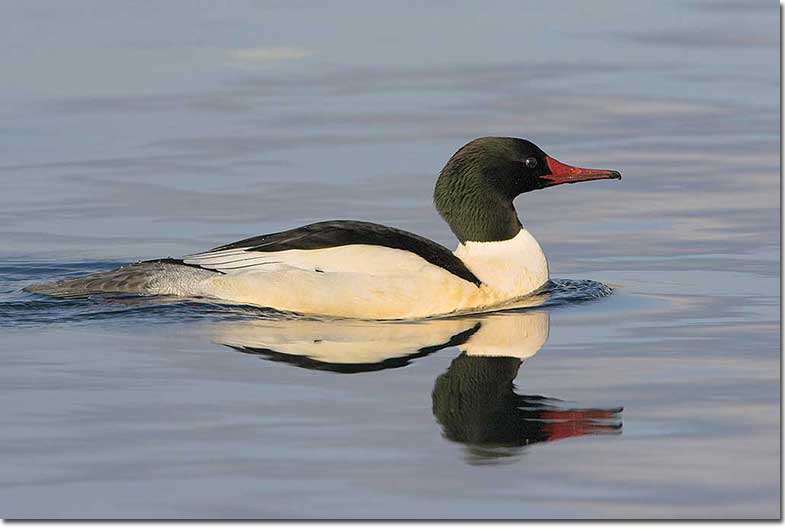
Scientific name: Mergus merganser
Length: 25 inches
Weight: 3.4 pounds
Wingspan: 34 inches
Song: “kook kuh ruh rah ruh rah”
The Common Merganser is a big diving duck with a pointed red-orange beak, and a large white patch in each wing.
Breeding males are ivory white with a glossy black-green head. They also have a black and white back and wings, and a wedge-shaped gray tail.
Females, juveniles, and non-breeding males are gray, have a white belly, brown head, and white throat.
Common Mergansers eat small fish, and also catch insects, crustaceans and other small animals. They forage by diving below the surface and snatching prey with their long, hooked beak.
This species nests in tree cavities and other holes and crevices. They line the bottom of the nest hole with wood chips and down feathers.
The Common Merganser breeds in forested lakes and rivers in Alaska, Canada, and the northern and western USA. They also live in Iceland and Eurasia. This species winters on lakes, reservoirs, and coastal waters in Canada and the northern and western USA.
Key Identifications:
- Large black and white or gray and white duck with a dark head and a pointed red-orange beak.
- Dives underwater to catch small fish and other small animals.
- Nests in a woodpecker hole or other cavities in forested areas near lakes and rivers.
- Occasionally makes croaking sounds, ““kook kuh ruh rah ruh rah””.
The Common Merganser is a big diving duck with a dark head, white patches in its wings, and a pointed, red-orange beak. This duck is common on northern and western lakes, big rivers, and reservoirs. Common Mergansers are also known as Goosanders, Sawbills, and Fish Ducks.
Common Goldeneye
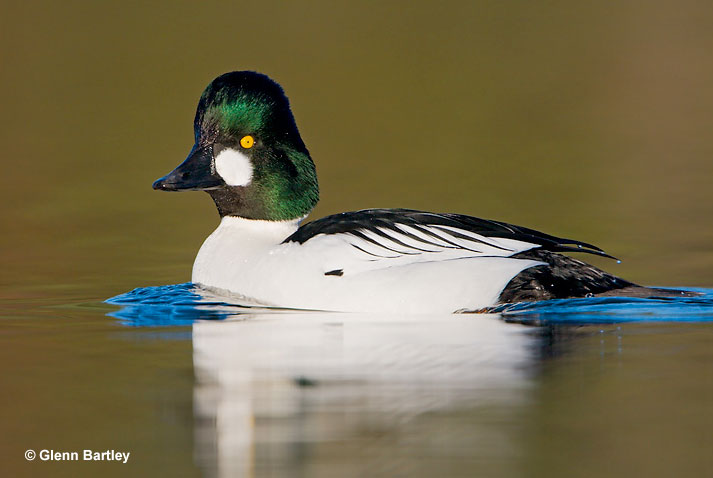
Scientific name: Bucephala clangula
Length: 18.5 inches
Weight: 1.9 pounds
Wingspan: 26 inches
Song: “rip rheeee”
The Common Goldeneye is a small to medium-sized duck with bright yellow eyes. Males are black and white, have a black head with metallic green iridescence, and an oval, white mark.
Females and young birds have a dark brown head, and are grayish-brown with a white belly. In flight, they show a big white patch on the base of their wings. Females also have a yellow tip on their beak.
Common Goldeneyes mostly eat mollusks, crustaceans, insects, and other small aquatic animals. They forage by diving and picking food from the bottom or from vegetation under the surface of the water.
This species nests in tree cavities and nest boxes. The female hollows out a shallow depression in the bottom of the cavity and lines it with down feathers.
Common Goldeneyes nest in boreal forests in Alaska and Canada, and winter on large lakes, reservoirs, and coastal waters in much of the USA and southern Canada. That makes them one of the most popular birds of Alaska.
Key Identifications:
- Small to medium-sized, black and white duck with an oval white spot on the face (male), or grayish-brown with a yellow tip on its beak and white belly (female).
- Dives below the water for mollusks and other small aquatic creatures.
- Nests in tree cavities and nesting boxes.
- Male in display makes a raspy call that sounds a bit like a very hoarse Red-winged Blackbird, “rip rheeee”.
Interestingly, these birds are known to leave the nest quite early. One day after hatching, baby Common Goldeneyes leave the nest and fall and tumble more than twenty feet to the ground.
Pelagic Cormorant
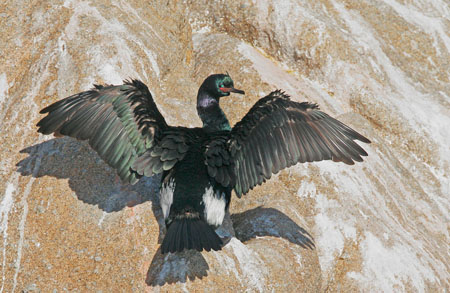
Scientific name: Urile pelagicus
Length: 28 inches
Weight: 3.9 pounds
Wingspan: 39 inches
Song: “wah wah wuh”
The Pelagic Cormorant is a large, slender, black waterbird with a thin bill.
Both sexes look similar and have glossy green and purple highlights in their plumage. In breeding season, they have a short double crest, and red on the base of their beak.
They also have a large white patch on the lower part of each flank. This field mark is mostly visible on flying birds.
Juvenile Pelagic Cormorants are completely dark.
Pelagic Cormorants dive in shallow coastal waters to catch fish, crustaceans, and other sea creatures. They like rocky reefs but can also forage in other types of coastal waters.
This species nests on sea cliffs, rocky ledges, and other inaccessible coastal spots. It makes a shallow nest out of seaweed, grass, and sticks held together by its own droppings.
The Pelagic Cormorant lives in coastal waters from Alaska to California and northern Mexico. It also lives in eastern Asia south to Taiwan.
Key Identifications:
- Big, dark, slender cormorant with a thin beak, and a white patch on the lower part of each flank.
- Forages in shallow coastal waters for fish and other small sea creatures.
- Nests on sea cliffs and other inaccessible coastal spots.
- Usually silent but occasionally makes moaning calls, “wah wah wuh”.
The Pelagic Cormorant is a large, black, slender seabird with a thin beak. It is common in coastal waters in much of its range. This bird can dive 33 feet deep to find food.
Common Redpoll
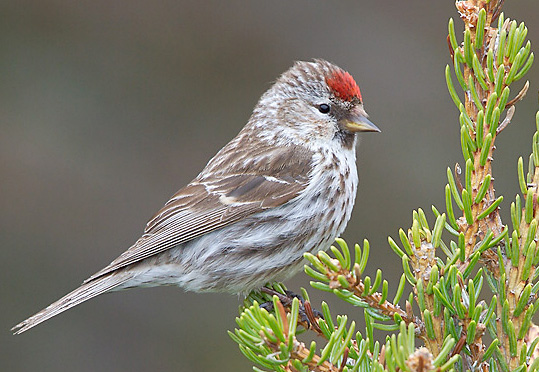
Photograph © Glenn Bartley.
Scientific name: Acanthis flammea
Length: 5.25 inches
Weight: .46 ounces
Wingspan: 9 inches
Song: “chip chip chreee chupchupchup”
The Common Redpoll is a small finch with a red spot on its head, some black on its face, and a slight, conical yellow beak. They have gray-brown streaking above and on their sides, two pale wing bars, and a forked tail.
Males Common Redpolls have pink or rose on their breast and face. Females look similar but lack pink colors and are more streaked below.
Common Redpolls forage for small seeds but also eat bugs during the summer months. They pick food from the ground, bushes, grassy vegetation, seed feeders, and trees.
This species nests in bushes and short trees. The female makes a small cup nest out of moss, twigs, and grass, and lines it with feathers.
Common Redpolls breed in subarctic and tundra habitats in northern North America and Eurasia. In winter, we can see them in a variety of open habitats from Alaska and Canada to the northern USA, and Europe.
Key Identifications:
- Small finch with gray-brown streaks, dark face, yellowish beak, and red spot on its head.
- Forages on the ground, in bushes, trees, and at feeders for small seeds.
- Nests in a bush or low tree in cold, northern regions.
- Males sing a short song of chipping calls and trills, “chip chip chreee chupchupchup”.
The Common Redpoll is a small, streaked finch with a yellow beak and a small red spot on its head. This bird is common on its far northern breeding grounds but, further south, can be common or rare during the winter. To survive cold weather, this species spends the night in tunnels it makes in the snow.
Chestnut-backed Chickadee
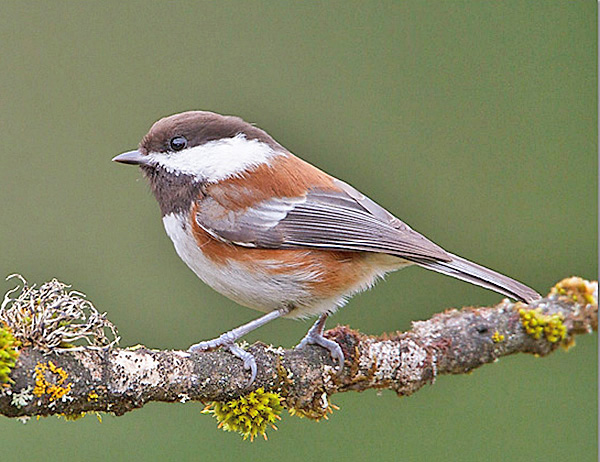
Photograph © Glenn Bartley
Scientific name: Poecile rufescens
Length: 4.75 inches
Weight: .34 ounces
Wingspan: 7.5 inches
Song: “sipidit sipidit”
The Chestnut-backed Chickadee is a small bird with a sooty cap, white face, and a black throat. It also has a red-brown back, flanks, and undertail, and a short, stubby bill.
Both sexes of this cute little bird look the same. They occur in chattering flocks with other small birds, and flutter between bushes and trees on short, rounded, dark gray wings.
Chestnut-backed Chickadees are busy little birds that feed on small insects, caterpillars, spiders, berries, and seeds. They pick these food items from foliage and bark, and are also regular visitors to bird feeders.
This chickadee species makes a nest out of animal hair and other soft materials at the bottom of a tree cavity. They can also use nest boxes and occur in dense coastal forests from southern Alaska to California. Another population lives in similar coniferous forests from southern British Colombia to Idaho and northeastern Oregon.
Key Identifications:
- Tiny red-brown and gray songbird with a sooty cap, white face, and black throat.
- Small, busy flocks forage for small arthropods and seeds in foliage and at feeders.
- Nests in tree cavities and nest boxes.
- This chickadee makes wheezy “dee dee” calls and higher-pitched, chittering sounds, “sipidit sipidit”.
The Chestnut-backed Chickadee is one of the common, classic small birds that live in the wet coniferous forests of the Pacific Northwest. They usually occur in flocks, visit feeders, and are pretty easy to see. This bird uses a lot of fur from Coyotes, rabbits, and other mammals in its nest, and even covers its eggs with fur.
American Wigeon
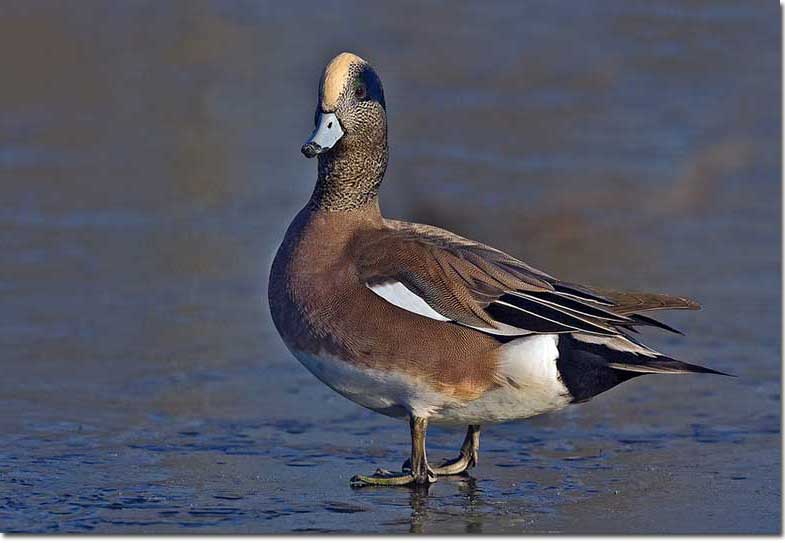
Scientific name: Mareca americana
Length: 20 inches
Weight: 1.6 pounds
Wingspan: 32 inches
Song: “reyah rih RIH RUH”
The American Wigeon is a fair-sized duck with a somewhat short, pale blue-gray beak, pointed tail, and a white belly.
Males have a head with a white crown, dark green mark, and a mottled gray face and throat. They have a beige-brown chest, sides, and back, and a black undertail. In flight, male American Wigeons wings show white shoulders, and a dark green patch.
Female American Wigeons have a finely mottled gray head and neck, some dark around their eyes, and an orange-brown chest and sides.
This species forages for aquatic plant matter and seeds by grazing and picking food from under the water.
Female American Wigeons make a shallow nest on the ground, often far from water, underneath bushes or in tall grass.
This duck breeds near shallow wetlands in Alaska, Canada, and parts of the northern USA. It winters in wetland habitats in western Canada, and many parts of the USA to Central America.
Key Identifications:
- Good sized beige and brown duck with a short blue gray beak, dark mark around or going back from the eye, white belly, and pointed tail.
- Forages on the ground and in shallow water for aquatic vegetation, and seeds.
- Nests on the ground under tall grass and scrubby vegetation.
- Occasionally makes odd whistling calls, “reyah rih RIH RUH”.
The American Wigeon is a fair-sized, beige and brown duck with a pointed tail, white belly, and short pale blue-gray beak. It is a common duck in shallow wetlands in much of its range. This species is also more adapted to walking on land and grazing like a small goose than other dabbling ducks.
FAQ
What birds are common in Alaska?
Common birds in Alaska include Bald Eagles, Common Ravens, various ducks and other aquatic birds, and birds of northern habitats.
What is the state bird of Alaska?
The state bird of Alaska is the Willow Ptarmigan. It was #120th in this list, just before Long-billed Dowitcher and behind the Northern Shrike.
What is the rarest bird in Alaska?
The rarest bird in Alaska is the Bristle-thighed Curlew. This species only breeds in Alaska and has a small estimated population of 3,500 adults.
What are the largest birds in Alaska?
The largest birds in Alaska are Trumpeter Swans. These big waterfowl species are 60 inches long, have an 80 inch wingspan, and weigh 23 pounds.
Do eagles live in Alaska?
Yes, many eagles live in Alaska. the Bald Eagle is one of the most common bird species and Golden Eagles also occur.
More in Alaska: Ducks | State bird

